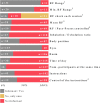Methods for Heart Rate Variability Biofeedback (HRVB): A Systematic Review and Guidelines
- PMID: 36917418
- PMCID: PMC10412682
- DOI: 10.1007/s10484-023-09582-6
Methods for Heart Rate Variability Biofeedback (HRVB): A Systematic Review and Guidelines
Abstract
Heart Rate Variability Biofeedback (HRVB) has been widely used to improve cardiovascular health and well-being. HRVB is based on breathing at an individual's resonance frequency, which stimulates respiratory sinus arrhythmia (RSA) and the baroreflex. There is, however, no methodological consensus on how to apply HRVB, while details about the protocol used are often not well reported. Thus, the objectives of this systematic review are to describe the different HRVB protocols and detect methodological concerns. PsycINFO, CINALH, Medline and Web of Science were searched between 2000 and April 2021. Data extraction and quality assessment were based on PRISMA guidelines. A total of 143 studies were finally included from any scientific field and any type of sample. Three protocols for HRVB were found: (i) "Optimal RF" (n = 37), each participant breathes at their previously detected RF; (ii) "Individual RF" (n = 48), each participant follows a biofeedback device that shows the optimal breathing rate based on cardiovascular data in real time, and (iii) "Preset-pace RF" (n = 51), all participants breathe at the same rate rate, usually 6 breaths/minute. In addition, we found several methodological differences for applying HRVB in terms of number of weeks, duration of breathing or combination of laboratory and home sessions. Remarkably, almost 2/3 of the studies did not report enough information to replicate the HRVB protocol in terms of breathing duration, inhalation/exhalation ratio, breathing control or body position. Methodological guidelines and a checklist are proposed to enhance the methodological quality of future HRVB studies and increase the information reported.
Keywords: Checklist; Deep breathing; Guidelines; Heart Rate Variability Biofeedback; RSA; Resonance frequency.
© 2023. The Author(s).
Conflict of interest statement
The authors have no competing interests to declare that are relevant to the content of this article.
Figures







References
-
- Appelhans BM, Luecken LJ. Heart Rate Variability as an index of regulated emotional responding. Review of General Psychology. 2006;10(3):229–240. doi: 10.1037/1089-2680.10.3.229. - DOI
Publication types
MeSH terms
LinkOut - more resources
Full Text Sources
Miscellaneous

